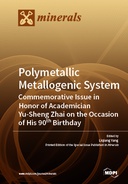Explore

Within the last decade, the high and continuing demand for precious and base metals, as well as critical elements, has prompted a global rush on a scale never before seen. This eventually resulted in the demand for considerable innovation and improvement in mineral deposit genetic modelling and ore formation regimes for the many different types of gold deposits, now recognized, and paralleled by the wide employment of exploration techniques and a rapid expansion of geological databases. This Special Issue will show case studies of porphyry polymetal systems, orogenic gold formations, water–rock reaction, ore-forming structure evolution, mineralogy and petrology of ore deposit, ore formation regime, geochronology and geochemistry of ore deposit, ore-forming evolution, mineral exploration and cutting-edge technology in ore deposit study.
This book is included in DOAB.
Why read this book? Have your say.
You must be logged in to comment.
Rights Information
Are you the author or publisher of this work? If so, you can claim it as yours by registering as an Unglue.it rights holder.Downloads
This work has been downloaded 167 times via unglue.it ebook links.
- 111 - pdf (CC BY-NC-ND) at Unglue.it.
Keywords
- A-type granite
- acidity
- archean basement
- Beiya Au deposit
- China
- Chishan alkaline complex
- constraints on mineralization
- Cu-Au hydrothermal mineralization
- C–H–O isotopes
- C–O isotopes
- Dongbulage
- fluid inclusion
- fluid inclusions
- formation temperature
- garnet Sm–Nd dating
- Geochemistry
- geochronology
- geostatistics
- gold deposition
- granite petrogenesis
- Great Xing’an Range
- Haoyaoerhudong gabbro
- Hegenshan-Heihe suture zone
- Hf isotopes
- Hf-Nd isotopic mapping
- high fugacity
- high-silica adakitic rocks (HSA)
- Hongshan skarn deposit
- Hongyan deposit
- Huangshaping
- hydrothermal alteration halo
- hydrothermal calcite
- hydrous melts
- H–O isotope
- immiscibility
- in situ study
- Inner Mongolia
- invisible gold
- Jiangnan orogenic belt
- Jiaodong
- Jiaodong area
- Jiaodong Peninsula
- Koka deposit
- LA-ICP-MS
- LA-ICP-MS zircon U–Pb dating
- Late Cretaceous
- Liaodong Peninsula
- Liaoning Province
- lithospheric architecture
- low Sr and high Yb A2-type granite
- Lu–Hf isotopes
- magmatic oxygen fugacity
- mantle branch
- metallogenesis
- metallogenic rule
- middle–late Jurassic
- mineral geo-thermometry
- Mo-polymetallic deposit
- molybdenite Re-Os dating
- molybdenite Re–Os dating
- n/a
- niobium mineralization
- North China Craton
- Northwestern Yunnan Province
- ore prospecting target
- ore shoots
- ore-controlling structures
- ore-forming processes
- orogenic gold deposit
- orogenic-gold deposit
- oxidation state
- paleo-Tethyan ocean closure
- Permian A-type granite
- petrogenesis
- Phapon gold deposit
- physicochemical condition of mineralization
- Pinglidian gold deposit
- post-collisional
- post-collisional slab break-off
- precipitation mechanism
- Pulang porphyry Cu (–Mo–Au) deposit
- Quartz
- quartz vein
- Rare-Earth Elements
- Re–Os dating
- rock geochemistry
- Saima deposit
- Sanshandao gold deposit
- SE China
- sericite
- Shizhuyuan
- Sizhuang gold deposit
- skarn mineralogy
- South China
- Sr–Nd isotopes
- Sr–Nd–Pb–Hf isotopes
- Stable isotopes
- Structural control
- SW China
- syenite
- Tiantangshan tin polymetallic deposit
- tin mineralization
- trace element
- U–Pb zircon age
- visible gold
- water–rock interaction
- Weilasituo Sn-polymetallic deposit
- West Qinling
- whole-rock geochemistry
- W–Sn skarn
- Xianghualing
- Yangshan gold belt
- Zaorendao gold deposit
- Zaozigou deposit
- Zhengchong gold deposit
- zircon geochronology
- zircon Hf isotopes
- zircon U-Pb dating
- zircon U–Pb dating
- zircon U–Pb geochronology
Links
DOI: 10.3390/books978-3-03921-294-1Editions


